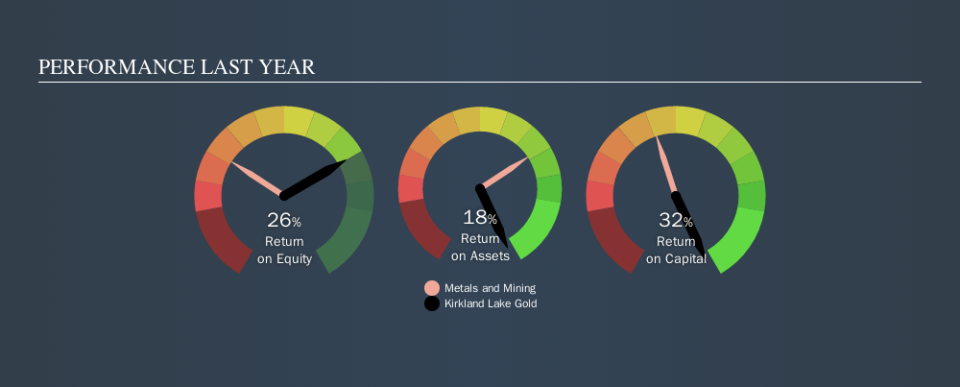Kirkland Lake Gold Ltd. (TSE:KL) Is Employing Capital Very Effectively

Today we'll evaluate Kirkland Lake Gold Ltd. (TSE:KL) to determine whether it could have potential as an investment idea. In particular, we'll consider its Return On Capital Employed (ROCE), as that can give us insight into how profitably the company is able to employ capital in its business.
Firstly, we'll go over how we calculate ROCE. Next, we'll compare it to others in its industry. Finally, we'll look at how its current liabilities affect its ROCE.
Understanding Return On Capital Employed (ROCE)
ROCE measures the amount of pre-tax profits a company can generate from the capital employed in its business. Generally speaking a higher ROCE is better. In brief, it is a useful tool, but it is not without drawbacks. Author Edwin Whiting says to be careful when comparing the ROCE of different businesses, since 'No two businesses are exactly alike.
How Do You Calculate Return On Capital Employed?
Analysts use this formula to calculate return on capital employed:
Return on Capital Employed = Earnings Before Interest and Tax (EBIT) ÷ (Total Assets - Current Liabilities)
Or for Kirkland Lake Gold:
0.32 = US$555m ÷ (US$2.0b - US$266m) (Based on the trailing twelve months to June 2019.)
Therefore, Kirkland Lake Gold has an ROCE of 32%.
View our latest analysis for Kirkland Lake Gold
Does Kirkland Lake Gold Have A Good ROCE?
One way to assess ROCE is to compare similar companies. Using our data, we find that Kirkland Lake Gold's ROCE is meaningfully better than the 3.4% average in the Metals and Mining industry. I think that's good to see, since it implies the company is better than other companies at making the most of its capital. Putting aside its position relative to its industry for now, in absolute terms, Kirkland Lake Gold's ROCE is currently very good.
In our analysis, Kirkland Lake Gold's ROCE appears to be 32%, compared to 3 years ago, when its ROCE was 9.8%. This makes us think the business might be improving. You can click on the image below to see (in greater detail) how Kirkland Lake Gold's past growth compares to other companies.
When considering ROCE, bear in mind that it reflects the past and does not necessarily predict the future. ROCE can be misleading for companies in cyclical industries, with returns looking impressive during the boom times, but very weak during the busts. ROCE is, after all, simply a snap shot of a single year. Given the industry it operates in, Kirkland Lake Gold could be considered cyclical. Future performance is what matters, and you can see analyst predictions in our free report on analyst forecasts for the company.
How Kirkland Lake Gold's Current Liabilities Impact Its ROCE
Short term (or current) liabilities, are things like supplier invoices, overdrafts, or tax bills that need to be paid within 12 months. Due to the way ROCE is calculated, a high level of current liabilities makes a company look as though it has less capital employed, and thus can (sometimes unfairly) boost the ROCE. To counter this, investors can check if a company has high current liabilities relative to total assets.
Kirkland Lake Gold has total liabilities of US$266m and total assets of US$2.0b. As a result, its current liabilities are equal to approximately 13% of its total assets. A minimal amount of current liabilities limits the impact on ROCE.
The Bottom Line On Kirkland Lake Gold's ROCE
This is good to see, and with such a high ROCE, Kirkland Lake Gold may be worth a closer look. Kirkland Lake Gold looks strong on this analysis, but there are plenty of other companies that could be a good opportunity . Here is a free list of companies growing earnings rapidly.
If you like to buy stocks alongside management, then you might just love this free list of companies. (Hint: insiders have been buying them).
We aim to bring you long-term focused research analysis driven by fundamental data. Note that our analysis may not factor in the latest price-sensitive company announcements or qualitative material.
If you spot an error that warrants correction, please contact the editor at editorial-team@simplywallst.com. This article by Simply Wall St is general in nature. It does not constitute a recommendation to buy or sell any stock, and does not take account of your objectives, or your financial situation. Simply Wall St has no position in the stocks mentioned. Thank you for reading.

 Yahoo Finance
Yahoo Finance 
